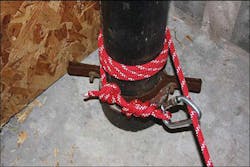In the last two articles, we focused on the foundation of mechanical advantage systems (MAS). We also touched on both anchor and belay systems. By now you should have a good base of knowledge regarding these topics so we'll dive into some of them a little deeper.
Our main focus in this article is going to be anchor systems. Simply put, without a good anchor system nothing else is possible.
We previously discussed anchor classifications. Those classifications being bomb-proof, questionable, and manufactured. Remember, we're always going to strive to achieve the bombproof rating. It may take some redirecting of ropes but as a wise chief of mine once said, you can "make it happen."
One of the most important features of an anchor system is the angle you create building it. This will apply to all anchor systems and their components.
Let's first look at a basic cache of anchor systems you should know inside and out.
Look at the single point anchor system. This is created by attaching the rope itself or the rope via an anchor strap to a single anchor point such as an I-beam or cement column. The load is focused on a single point.
If the load I was supporting or hauling was 500 pounds the anchor would see a load force of 500 pounds. If you choose to utilize a single point anchor system, one method that works well is referred to as a tensionless wrap. A tensionless wrap works by utilizing friction and here's how.
The rope is wrapped around the object a minimum of four to six times. Smaller anchor objects will need more wraps to achieve the needed friction. As the load force is applied the torsional load placed on the wraps causes them to tighten and form a secure anchor system. The terminal end of the rope (the piece you used to wrap the anchor with) will have a Figure 8 Bight tied in it and will get connected back onto itself (see Figure 1.)
One of the biggest positive characteristics of this anchor method is because the wraps take all the force and the rope itself retains 100 percent of its strength.
Anchor straps and slings also work well for single point anchor systems however you must ensure they are of the proper length to avoid unwanted directional loads on the software (see Figure 2.)
We must touch on critical angles or the angles created by components in our anchor system.
If you look at Figure 2, you will see a triangle is created by a length of half-inch static kernmantle rope. That angle should stay between 45 and 90 degrees.
Let's take a load of 100 pounds. If we create an angle of 45 degrees each side of the anchor strap will see about 52 pounds. Let's increase the angle to 90 degrees, now each side of the anchor strap will see a load force of approximately 70 pounds. If we take that angle and bump it up to 123 degrees, the load force on each side of the anchor strap is now around 100 pounds.
Look at the bigger picture. Those loads are transferred back to the anchors and anchor system components. The less stress and unneeded load force we create in our system, naturally the better off we'll be.
Now that we've talked about angles created in anchor systems and the importance of keeping them within the suggested guidelines let's move onto more means of anchoring.
Webbing is a tool you can use to create anchor systems with. Webbing is strong by design. You'll find webbing in two forms, flat and tubular. One-inch tubular webbing has a load rating of 4,000 pounds, where as one-inch flat webbing has a load rating of 6,000 pounds. One-inch diameter webbing is probably the most popular choice for rope rescue operations.
The "wrap three, pull two" is a quick efficient way to create a strong single point anchor system (Figure 3.) One-inch tubular webbing is used which is rated for four thousand pounds. By wrapping the webbing around the anchor object three times then pulling two loops of the webbing to create a connection point, we create an anchor system rated for approximately 16,000 pounds.
Here's the math. Two anchor legs on each side rated at 4,000 pounds each = 8,000 pounds. 8,000 pounds x 2 = 16,000 pounds. If you look at the picture, you'll notice the water knot is located on the back of the anchor and not part of the two wraps we've pulled. That's because the knot is the weakest point in this system.
By positioning it where we did the wraps in the system absorb most of the friction that the knot would have seen. On a side note, remember always leave about two inches of tail on either side of your water knot for safeties (see Figure 4.)
Another basic anchoring method is called a load sharing anchor system and it does just that. This is created by using two separate anchor points which in essence will become one. In Figure 5, you can see this anchor system created by using two pieces of one-inch webbing. Our degree of angles really comes into play now.
Remember as we said earlier, we want to keep the angles we create in the area of 45 to90 degrees. The angle we have in Figure 5 is 45 degrees. So if our load was one thousand pounds, each side of the anchor system will see approximately 500 pounds. Load sharing anchor systems are great when your load force is directed downward in a straight line.
How about if there is the possibility of your load moving from side to side? Simple solution, it's called a load distributing anchor system. This is a system comprised of two or more anchor points designed to move with the load. In other words, if your load moves to the right the anchor system would equalize the load amongst all the anchor points.
If you look at Figure 6 you will see an example of a two point load distributing anchor system. It's utilizing two anchors just like a load sharing anchor system however by rigging or building it differently we can achieve a different type of anchor system that will equally distribute the load amongst itself as opposed to only sharing the load equally in a vertically plumb direction .
A good habit to get into is backing up all your anchors. In Figure 7 you can see an example of this. Some may say this is overkill when using bombproof anchors; however if you have the gear it will take all of a minute to further ensure your safety. In Figure 7 we simply tied a directional eight (a form of the Figure 8 Bight knot that can be tied to face left or right), wrapped the anchor with a piece of one inch webbing and made our connection. All of this is done in under one minute. An extra minute in your rigging is worth the extra safety it provides, if you were to ask my opinion.
Knowing how to construct these anchor systems is only three quarters of the skill set you should have. There are circumstances where your anchor points won't line up with the ropes needed location. This is not a big deal. We can use what's called a directional pulley, or "directional." A directional pulley is rigged to a separate anchor point and if need be, extended to a desired length to direct the rope in its needed position. Ideally the anchor point chosen for this should be considered bombproof. If it's not it must be backed up with an anchor point of equal or greater strength. You can see an example of this in Figure 8.
The foundation of all the skills we've talked about in this article will stem back to how to choose an anchor and what characteristics to look for. We talked about bombproof and questionable anchors and the difference not only between them but how our rigging will differ. We should also be looking for abrasion points, or rough and/or sharp areas of that anchor object that will damage the rope. If you do find trouble spots simply pad these areas out with rope pads, rope bags, or whatever will do the trick. Once the system is loaded, monitor these areas to ensure the rope hasn't moved off of the protection in place. It's also a good idea to find an anchor that is in-line with the desired rope destination. By doing this you can avoid using a directional pulley.
Keep the big picture in mind and avoid getting tunnel vision. Here is an example for you. If I brought you to a bombproof anchor and told you I needed four separate anchor attachments using one length of rope to create them, how would you do it? The answer is shown in Figure 9. Every time you tie a Figure 8 Bight in the rope in essence your now working with a new length of rope. So by doing this I can achieve multiple anchor attachment points that are isolated from each other utilizing only one length of rope.
Here's another example. You are asked to create a belay and anchor system using only one rope. Figure 10 shows how this can be done. A Figure 8 follow through makes your anchor connection then a Directional 8 is tied facing the anchor to serve as a back up connection point. Finally another Directional 8 facing the load is tied (a butterfly knot will work as well.) This knot receives a carabiner where tandem triple wrap prusiks will make their connection to the belay line. Pull all the slack in the line up through the prusiks and you're ready to go.
Whether you're rigging operations easy or challenging, the bottom line is they don't have to be complex. Whether you're rigging anchor systems, belay systems, or building a MAS keep it simple, avoid tunnel vision and focus on the operation as a whole. The bigger the picture the more rigging opportunities you will find.
Stay safe and stay progressive.
About the Author

Michael Donahue
Owner and founder of Progressive Rescue, Mike Donahue is a 13-year veteran to the fire service. In those thirteen years Mike has experience as both a volunteer and federal firefighter and has been a career firefighter in the City of Elizabeth for the last 10 years, the last seven of which and currently working out of Rescue Company 1. Mike holds the title of Rescue Specialist with New Jersey's urban search and rescue team (NJ-TF1). You can find Mike actively teaching at Middlesex and Somerset Fire Academies as well as Middlesex County College as an Adjunct Professor and the Fire Science Program coordinator. He is actively involved in writing new course programs for the various organizations he teaches for. Mike has reviewed several text books for publishers such as Delmar and Jones & Bartlett. Mike has also co-written the new rope program for Jones & Bartlett and taught Rope Rescue Made Simple at Firehouse Expo 2010. Mike also is a monthly columnist for Firehouse.com covering the area of technical rescue. His teaching techniques and cutting edge style have gained the respect from many of his peers. Mike's passion, experience and desire to educate emergency service providers prove to be the driving force that has made him so successful. Progressive Rescue prides itself on providing the most cutting edge, diverse instructional programs available. We strive to provide your department with the most comprehensive, dynamic learning experience available at a truly competitive price. You can reach Mike by e-mail at [email protected]
